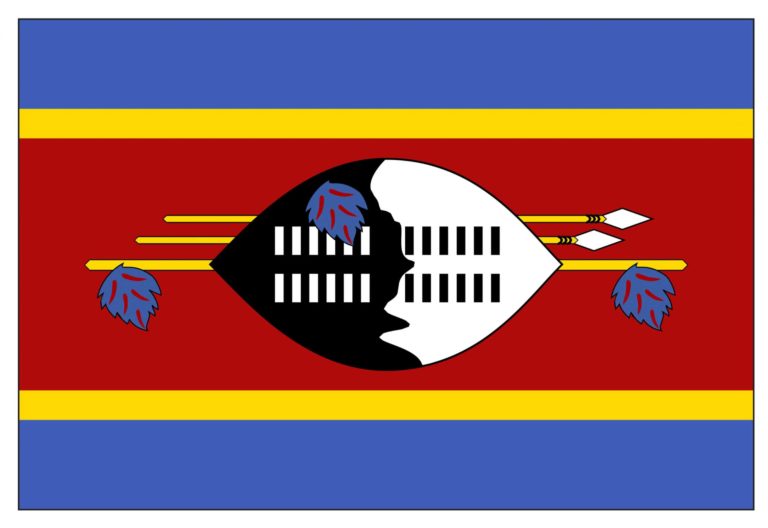ESWATINI (SWAZILAND)
Compliant HR, Payroll, Tax & Employer of Record Africa

OVERVIEW
The Kingdom of eSwatini receives more than most other African countries in remittances per capita, as neighbour of South Africa. And is one of the world’s last remaining absolute monarchies, is the kingdom of eSwatini.
A countryside following traditional ways of life ruled by the king by decree over his million subjects.
The country, known as Swaziland, would henceforth be called eSwatini, a move critic said was made without consultation and needed a constitutional change the King announced, during 2018.
Many Swazis work in South Africa and send their earnings home.
eSwatini according to UNICEF, has the highest HIV prevalence rate in the world. The HIV-Aids virus has killed countless Swazis and left thousands of orphans. Approximately 210,000 people, out of a population of 1.2 million, are estimated to be living with HIV.
King Swati III was crowned in 1986 at the age of 18, succeeding his long-serving father King Sobhuza II, who died at the age of 82.
GENERAL INFORMATION

CAPITAL CITY
Mbabane

OFFICIAL LANGUAGE
siSwati and English

CURRENCY
Lilangeni E

DIALLING CODE
+268

TAX AUTHORITY
Eswatini Revenue Authority

TAX YEAR
1 January – 31 December

TIME ZONE
(GMT + 2)
GENERAL INFORMATION

CAPITAL CITY
Mbabane

OFFICIAL LANGUAGE
siSwati and English

CURRENCY
Lilangeni E

DIALLING CODE
+268

TAX AUTHORITY
Eswatini Revenue Authority

TAX YEAR
1 January – 31 December

TIME ZONE
(GMT + 2)
MORE INFORMATION
The early 21st century has seen increased pressure from opposition groups for limitation of the powers of the king, who has been criticized for abuse of power and personal indulgence, and established a democratically elected parliament, but the king has steadfastly resisted making any significant changes. The king approved a new constitution in July 2005, did not diminish the king’s ultimate hold on power. The same month the African Union’s human rights commission criticized the country for failing to conform with the African Charter and gave the government six months to rectify the situation.
Official Holidays:
1 January – New Year’s Day
19 April – Good Friday/Kings Birthday
22 April – Easter
25 April – National Flag Day
1 May – Employees’ Day
30 May – Ascension Day
22 July – Kings Fathers Birthday
7 September -Victory Day
2 September – Reed Dance
6 September – Somhlolo Day
25 December – Christmas Day
26 December – Boxing day
Passports & Visas Information
Immigration Procedures
The borders posts between Swaziland and neighbouring South Africa and Mozambique are international crossings and you will need a valid passport. Tourists are generally granted a 30-day period to enjoy the country. If you wish to stay longer, such as when working on a volunteer project you will need to approach the Ministry of Home Affairs in Mbabane for an extension. If you plan to work or be remunerated for work in Swaziland, you will need to apply for a Temporary Residence
If you are in South Africa and/or Mozambique on a single-entry visa, be aware that once you have left these countries, you cannot automatically go back without re-applying for a new visa. Such re-application may be subject to restrictions, so it is best that you check this out carefully.
If you are in South Africa and/or Mozambique on a single-entry visa, be aware that once you have left these countries, you cannot automatically go back without re-applying for a new visa. Such re-application may be subject to restrictions, so it is best that you check this out carefully.
Customs Procedures
Visitors can temporarily import their personal belongings without paying import duties or tax, for example: cameras, laptops, camping and recreational equipment etc. However, one may be required to fill out a Temporary Importation permit. If temporarily imported goods are discarded of in Swaziland V.A.T for that item or items will be payable.
Prohibitions and Restrictions
Endangered species (or parts thereof), dangerous drugs (narcotics). Arms, ammunition and live animals are susceptible to import controls and must be declared. There are restrictions to the importation of meat, dairy products, vegetables, fruits and plants: please declare them to an SRA officer and request advice on the requirements.
Penalties
Goods not declared in full or accompanied with false invoices will be detained and subject to forfeiture. Persons evading V.A.T may lead to prosecution in the Courts and subjection to penalties and fines – and can possibly lead to imprisonment.
Tax free allowances:
Visitors and Returning residents entering Swaziland can bring in consumable goods for their own consumption, like food (not intended for commercial purposes or sale) to the value of ZAR 1000.00 per individual, and ZAR 2 000.00 per family traveling together (one such importation per day). Additional goods above these allowances are liable for 14{8870c2225e05d1feea6df94638aa7ff56b3555cf8fa8f542e1293bebc40085d1} V.A.T.
Tax rates:
Income tax is levied on all income derived from a source within or deemed to be within the country, irrespective of whether the recipient of the income is actually resident in Swaziland.
Swaziland assesses resident and non-resident individuals on a graduated/progressive tax rate basis.
Taxable income (SZL*) | Tax rate | |
Over | Not over | |
0 | 100,000 | SZL 0 plus 20{8870c2225e05d1feea6df94638aa7ff56b3555cf8fa8f542e1293bebc40085d1} of taxable income in excess of SZL 0 |
100,000 | 150,000 | SZL 20,000 plus 25{8870c2225e05d1feea6df94638aa7ff56b3555cf8fa8f542e1293bebc40085d1} of taxable income in excess of SZL 100,000 |
150,000 | 200,000 | SZL 32,500 plus 30{8870c2225e05d1feea6df94638aa7ff56b3555cf8fa8f542e1293bebc40085d1} of taxable income in excess of SZL 150,000 |
200,000 | and above | SZL 47,500 plus 33{8870c2225e05d1feea6df94638aa7ff56b3555cf8fa8f542e1293bebc40085d1} of taxable income in excess of SZL 200,000 |
* Swaziland lilangeni
A rebate of SZL 8,200 (SZL 10,900 for those over age 60) per annum is applied to the annualized tax calculated. In essence, no tax is payable below an annual taxable salary of SZL 41,000 per annum
Deductions:
Pension fund contributions, up to 10{8870c2225e05d1feea6df94638aa7ff56b3555cf8fa8f542e1293bebc40085d1} of gross salary, by persons holding appointed office or employment.
Retirement annuity fund contributions (i.e. contributions during the year of assessment by members of the fund), with the sum of these contributions not to exceed 15{8870c2225e05d1feea6df94638aa7ff56b3555cf8fa8f542e1293bebc40085d1} of the taxable income accruing to the taxpayer from the trade carried out by the taxpayer, provided that the total amount allowed as a deduction shall be reduced by any contributions made by the taxpayer to a pension fund.
10{8870c2225e05d1feea6df94638aa7ff56b3555cf8fa8f542e1293bebc40085d1} of the mortgage interest paid to an approved financial institution at commercial rates, up to a maximum of SZL 2,400, provided that the individual is residing in the house.
No deduction is allowed for medical expenses.
Double taxation agreements:
Swaziland has concluded Double Taxation Agreements (DTA) with the following countries: South Africa, Mauritius, United Kingdom, Seychelles, Taiwan
Employer of Record Eswatini (Swaziland) Africa
Although an Employer of Record often works with a staffing agency, the two are separate business entities. Each has specific roles and responsibilities in their symbiotic relationship. We Handle Employer of Record and Payroll throughout Africa.
Purpose
An employer of record serves as an employer for tax purposes while an employee performs work for the client, such as a staffing firm or other business. An employer of record handles all personnel functions, including payroll processing and funding; tax deposits and filing; and employment contracts and paperwork. Maintaining a Certificate of Insurance, and Verification forms; unemployment insurance; and employees’ compensation are done. An employer of record also performs background checks and drug screenings; administers benefits; terminates employees; and may handle worker issues. Conversely, a staffing firm recruits’ employee and assigns them to businesses for worker absences, temporary skill shortages, seasonal work, or special projects. Their focus is to match temporary, temp-to-hire, long-term, or permanent employees with clients in need.
Benefits
Using an employer of record allows the client company to free up time and cost-effectively outsource its necessary human resource functions, employee benefits, payroll, employees’ compensation, and compliance issues. The money saved by outsourcing these functions can be used to expand the business, provide steady income for the owner, or fill a variety of other purposes. Onboarding quality talent is done quickly by an employer of record so clients can quickly ramp up staff and staffing agencies can deliver top quality employees to their clients. Most staffing agency owners don’t have the HR training, payroll and accounting skills, compliance knowledge, or risk management, insurance, and employee benefits background to meet the demands of being an employer.
Responsibilities and Liabilities
The client company or staffing agency owner retains control over business operations and responsibility for workplace safety and compliance. The employer of record assumes responsibilities and liabilities for employment issues such as administration, payroll, taxes, benefits, and maintaining employee records. Because the employer of record assumes most of the responsibility for compliance and tax laws, the client or staffing services owner receives peace of mind, knowing their business is being taken care of by qualified professionals.
Whereas an employer of record and staffing agency often work together, they have diverse purposes in the workplace.
It is a legal requirement to have a written employment contract in place in the local language in Swaziland, which lays out the terms of the employee’s compensation, benefits, and termination requirements. Offer letters and employment contracts should state the salary and compensation amounts in Swazi lilangeni.
Changes in terms of employment
Where the terms of employment given to the employee are changed, the employer shall notify the employee in writing specifying the changes which are being made and subject to the following subsections, the changed terms set out in the notification shall be deemed to be effective and to be part of the terms of service of that employee.
Where, in the employee’s opinion, the changes notified to him/her would result in less favourable terms and conditions of employment than those previously enjoyed by him/her, the employee may, within fourteen days of such notification, request his employer, in writing, (sending a copy of the request to the Labour Commissioner), to submit to the Labour Commissioner a copy of the form given to him/her, , together with the notification and the employer shall comply with the request within three days of it being received by him/her.
On receipt of the copy of the documents sent to him/her/her the Labour Commissioner shall examine the changes in the terms of employment contained in the notification.
Where, in his opinion, the changes would result in less favourable terms and conditions of employment than those enjoyed by the employee in question prior to the changes set out in the notification, the Labour Commissioner shall, within fourteen days of the receipt of the notification, inform the employer in writing of this opinion and the notification given to the employee shall be null void and of no effect.
Any person dissatisfied with any decision made by the Labour Commissioner may apply in writing for a review to the Labour Commissioner, who using the powers accorded to him/her, shall endeavour to settle the matter.
Where he is unable to do so within fourteen days of the receipt of the application being made to him/her he shall refer the matter to the Industrial Court which may make an order.
No contract of employment shall provide for any employee any less favourable condition than is required by any law. Any condition in a contract of employment which does not conform with this Act or any other law shall be null, and void and the contract shall be interpreted as if for that condition there were substituted the appropriate condition required by law.
Maternity leave
Every female employee, whether married or unmarried, who has been in the continuous employment of her employer for twelve months or more shall be entitled to maternity leave with a minimum of at least two weeks full pay upon delivering to her employer
- a certificate issued by a medical practitioner or a midwife setting forth the expected date of her confinement;
- a certificate issued by a medical practitioner or a midwife setting forth the actual date of her confinement; or
- such other evidence in support of the entitlement to maternity leave as is reasonable, having regard to all the circumstances of the case.
A female employee entitled to maternity leave shall be so entitled as least once after the lapse of a period of 24 months from the last maternity leave
Maternity leave shall not be less than twelve weeks, so arranged that the employee is allowed —
- such period as she desires not exceeding six weeks, before the date of confinement;
- a period of not less than six weeks from the date of the confinement.
Except where it is a written condition of her employment that maternity leave shall not be less than twelve weeks, an employee may, entirely at her own option, agree to a period of maternity leave of less than twelve weeks.
Where confinement takes place without an employee having been granted her entitlement of maternity leave, or where the period of such leave taken before her confinement amounts to less than six weeks, the period of maternity leave after confinement shall, if the employee so desires, be extended so that the total period of such leave amounts to not less than twelve weeks.
Where an employee has been granted maternity leave and the date of confinement is a later date than that stated in the certificate or other evidence delivered to the employer under section 102 as being the date on which confinement was expected, her maternity leave shall be extended to include the period that elapsed between those dates.
Every female employee shall be entitled to a one-hour nursing break with pay per day three months after maternity leave.
Additional leave
An employee who suffers any illness arising out of her confinement, shall be granted, in addition to the maternity leave to which she is entitled under section 103, such additional leave, not exceeding six weeks, as a medical practitioner may recommend.
Protection of employment.
An employer shall not —
- terminate the services of, or give notice of such termination to an employee at any time between the date of her delivery to him/her of a certificate or other evidence of her entitlement to maternity leave and the date of the expiration of her maternity leave or additional leave granted;
- give notice of termination of services to an employee so that it would expire during her maternity leave or the additional leave granted or terminate her services during such leave;
- terminate the services of an employee or require an employee to resign on the grounds that she is pregnant;
- require an employee to resign during any of the times referred to in paragraphs (a) and (b).
(2) Subsection (1) shall not apply to an employee whose services are terminated for any of the reasons set out in section 36.
Protection of seniority
Where an employee resumes employment after being granted maternity leave or additional leave she shall be entitled to continue in her former work or equivalent work without loss of seniority and she shall not, by reason only of the fact that she went on maternity leave, be paid lower wages or employed on less advantageous terms and conditions than those which were in place to her employment before she went on leave. No obligation to pay for maternity leave. Except as provided in section 102, nothing in this part shall be construed as requiring any employer to pay an employee for any time spent on maternity leave.
ANNUAL LEAVE
Employer to give paid annual holidays.
After each twelve months of employment with an employer, an employee shall be given not less than two weeks holiday and shall be paid in respect of such holiday the wages he would have been paid for the time (other than overtime) he would normally have worked during that period.
An employee shall not be entitled to the paid annual holiday in respect of any twelve months during which he attended work if he/she has been absent from work for thirty-six or more normal working days during that period, except where such absence has been due to sickness certified by a medical practitioner, maternity leave to which the employee is entitled approved by his employer.
- every employee shall be given the paid holiday provided for in this Act not later than six months after the completion of the twelve months in which the holiday has been earned.
- Where an employee is entitled to a paid annual holiday under this Part the employer shall permit the employee to take the annual holiday in one unbroken period, or at the request of the employee, in two or more periods, one of which must be a continuous period of not less than one week.
- When an employer elects to close a section or sections of his establishment for a fixed period in any year, all or part of the paid annual holiday may, by agreement between the parties, be taken before the completion of the twelve months in respect of which the paid annual holiday may be due. (4) An employer may agree in writing with all or any of his employees that one week of the annual holiday in each twelve months may be deferred and accumulated over a period not exceeding four years.
SICK LEAVE
Payment during sickness
After three months continuous employment with the same employer, an employee shall be eligible, in each year of employment with that employer, for a maximum of fourteen days sick leave on full pay and a maximum of fourteen days sick leave on half pay.
Payment for sick leave shall be made by the employer at the employee’s basic rate of wages, except that where the employee is employed on a wage other than a fixed wage he shall be paid, in respect of each day’s sick leave on full pay the same amount, and in respect of each day’s sick leave on half pay, half such amount, as equals the average amount of wages he received in respect of each day’s employment during the week in which he was last employed before the week during which his sick leave commenced. Sickness to be certified by medical practitioner.
Payment in respect of sick leave shall be subject to the employee producing a certificate of incapacity covering the period of sick leave claimed signed by a medical practitioner and no employee shall be entitled to paid sick leave unless this section has been complied with.
Nothing shall be deemed to prevent an employer granting paid sick leave in excess of that provided from granting paid sick leave to an employee who satisfies him/her, other than by the production of a medical certificate, that he was, for reasons of sickness, unable to carry out his normal duties on any day.
Offences and Penalties
Any employer who —
(a) fails to grant an employee an annual holiday as required by this Part or who fails to pay an employee the wages to which he is entitled;
(b) fails to pay an employee whose services are being terminated the amount to which is entitled
or (c) fails to pay to an employee any amount to which he is entitled in respect of paid sick leave; shall be guilty of an offence and shall be liable on conviction to a fine of not exceeding three thousand Emalangeni or to imprisonment not exceeding one year or both.
Compassionate leave
An employee shall be entitled to a total of one-month compassionate leave annually but nothing in this section shall be construed as requiring an employer to pay an employee for any time spent on such leave.
This section shall apply only upon the death of an employee’s immediate family.
Payment for annual holiday when employment is terminated
Where the employment of an employee is terminated after a period exceeding three months but not amounting to one year from the date of its commencement, or after a period of employment following the completion of a year in respect of which the paid annual holiday has been taken, the employer shall, on or before the date of such termination, pay to the employee a sum equal to not less than one day’s wages for each completed month of such period.
When an employee has completed one year’s continuous service with an employer and the employment is subsequently terminated, the employer shall, if the employee has not taken the paid annual holiday due to him/her in respect of that year’s employment on or before the date of such termination, pay to the employee the wages due to him/her in respect of such paid annual holiday, together with a sum equal to not less than one day’s wages due to him/her in respect of each completed month of employment following the completion of the last year in respect of which he has earned a paid annual holiday.
When an employer gives notice of termination of employment of the employee, payment to the employee of all or any part of the wages on account of the paid annual holiday to which he is entitled shall be deemed not to be payment of all or any part of his wages in respect of the period for which he is, under this Act, or by custom or agreement, or under his contract of service, entitled to continue in the employment after the giving of the notice.
Continuity of employment
For the purpose of this Part, employment shall be deemed to continue so long as the employee continues to be employed in the undertaking and shall be deemed not to be discontinued by the termination of any contract of employment entered into by the employee, if within a period of seven days of such termination such employee is re-engaged in the same undertaking. Wages in respect of annual holiday.
Wages in respect of the paid annual holiday shall be paid in advance not later than the last working day preceding such holiday.
Any payments made to an employee in respect of an annual holiday under this Part shall be in addition to and not in substitution for any other payment or consideration to which the employee is entitled under his contract of employment and this Act and no employer shall require any employee to take his annual holiday during the period of notice of termination of employment by the employer.
Public holidays occurring during annual holiday
Where during any annual holiday or part thereof being taken by an employee, any paid public holiday occurs, the period of the annual holiday shall be increased by one day in respect of that public holiday and wages payable to the employee in respect of the annual holiday shall include one day’s wages for each such public holiday.
(1) Every employer shall always keep a record showing in the case of each of his employees —
(a)the name of the employee;
(b)the dates of the commencement and termination of his employment;
(c)the dates on which the paid annual holiday is taken;
(d)the amount paid to the employee in respect of the paid annual holiday to which he is entitled
The record of paid annual holidays may be incorporated in the wages record required to be kept.
Probation
Probationary periods of up to three months are permitted. Employees performing either supervisory technical or confidential work may have a longer probationary period, but this will need to be agreed to in writing.
Notice of termination & severance
Employers may terminate employees with the following notice periods:
- After the probationary period and one month of employment: one week’s notice
- three to twelve months’ employment: two days for each completed month of continuous employment
- more than twelve months’ employment: one month plus four days for each completed year
An employee may be paid in lieu of notice.
Unless otherwise noted in the labour laws, a terminated employee is eligible for severance pay of 10 working day’s wages for each completed year of service after the first year.



